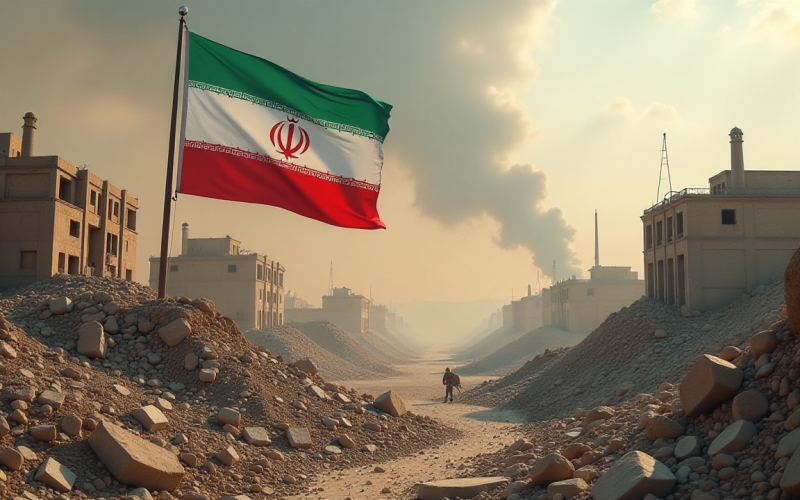Iran’s economy is barely holding together. In fact, it was collapsing before the war even began.
As missile strikes with Israel escalate, and global tensions keep rising, a question gets overlooked. Can Tehran actually afford this?
The data shows a plummeting currency, hyperinflation, and a source of income that is no longer sustainable.
What used to be a resource-rich power in the region now relies almost entirely on one buyer, China, and sells its oil at a discount just to keep the lights on.
Many are wondering if and how this conflict could end, and the real answer lies in the numbers.
How bad is the damage?
Iran’s economy is shrinking, fast. In 2025, its nominal GDP fell from $401 billion to $341 billion, according to the IMF.
Its per capita ranking dropped to 117th in the world. That’s far behind regional peers like Türkiye, the UAE, and Saudi Arabia, despite Iran having a much larger population.
The rial lost nearly half its value in 2024 and now trades at around 1,000,000 to the US dollar. The currency’s overall devaluation now stands at around 2,800% over the past decade.
In March this year, Iran’s parliament decided to impeach the country’s finance minister, just 6 months into his tenure.
Moreover, inflation is reported at 43%, but some estimates place it above 50%, especially for imported goods like food and medicine.
Iran’s poverty rate is at least 27%, though experts believe the real figure is closer to half the population.
Youth unemployment is over 19%, and most working adults earn under the table, with no contracts or benefits. More than 70% of the workforce is in the informal economy.
This kind of weakness wasn’t created overnight. It’s the result of more than a decade of economic decline, sanctions, policy failure, and a lack of meaningful reform.
Iran’s economy has been shrinking long before the latest escalation.
Can Iran still sell oil?
Iran’s economy has been shrinking long before the latest escalation. And at the center of it is a collapsing financial model. Over-reliance on oil.
Before the first wave of nuclear sanctions in 2012, Iran was exporting around 2.5 million oil barrels per day. That dropped below 400,000 by 2019.
In 2024, Iran was managing to sell around 1.5 million barrels per day, mostly to China, and at a steep discount. However, that changed after Israel’s recent strikes.
This past week, exports fell below 110,000 barrels per day, according to data from Kpler and Vortexa.
Kharg Island, Iran’s main crude terminal, has been inactive since the start of the strikes. South Pars, which produces about 80% of Iran’s gas, was partially shut down. Fuel depots near Tehran have also been targeted.
Even during peacetime, Iran was selling oil at a $3–6 discount per barrel to Chinese “teapot” refineries. It wasn’t making enough. Now, it’s barely making anything.
Is there any money left?
Iran has $33 billion in foreign reserves, but using that to fund a war would put long-term solvency at risk.
According to IMF figures, Iran would need oil prices to hit $163 per barrel just to balance its 2025 budget. Current prices are less than half that.
The state is already stretched. 73% of operating costs are now funded through taxes, and Iran has one of the world’s lowest formal employment rates.
The budget deficit is roughly one-third of public spending. Debt is rising and could pass 40% of GDP next year.
Capital is fleeing the country. More than $14 billion left in the last nine months of 2024, on top of $20 billion the year before. Investment is frozen. Iran’s share of global exports is down to just 0.23%.
Does the regime have support?
There’s still some nationalism, but it’s fragile. People are angry, tired, and poor. Since the death of Mahsa Amini in 2022, protests have been widespread.
Sanctions, inflation, and repression have left Iran’s middle class broken. More than a million educated Iranians have left the country in the past decade.
President Masoud Pezeshkian has said the economic situation is worse than during the Iran-Iraq War. He isn’t exaggerating. Infrastructure is failing.
Tehran’s reservoirs are at 7% capacity. Power outages are common. Food and medicine are expensive. Public trust is low.
So far, the war has triggered some patriotic sentiment. But that could reverse quickly if Israeli strikes continue and civilian casualties rise.
Can Iran sustain this war?
No. It can launch missiles, fund proxies, and retaliate for now. But it can’t keep going for long. The regime is running out of economic options.
Oil exports are drying up. Gas production is disrupted. Foreign reserves are limited. Domestic income is collapsing.
Energy exports, which are the entire foundation of Iran’s state economy, are under siege. Even before the war, China was its only real customer. Now, the shipments have slowed or stopped, and Beijing is under pressure not to help.
A war economy requires either surplus revenue, strong allies, or resilient institutions. Iran has none of the three.
Its military spending, estimated at $12 billion, is just 3–5% of GDP, far below Israel’s. It has no coalition backing, and its regional influence is fading.
Hezbollah has been hit. Assad is gone. Hamas is isolated.
If the fighting continues, Iran faces two options: negotiate from weakness or risk collapse. Neither outcome favors the regime.
Final outlook
Iran’s economy is already broken. The war is speeding up what years of corruption, sanctions, and mismanagement had already set in motion. Unless it finds a quick off-ramp, Tehran will face a steep contraction by the end of the year.
The IMF warns of a 10% drop in GDP, with inflation spiking and the rial in freefall. Oil revenue will keep falling. Foreign reserves will shrink. And public anger will grow.
Iran is now at a dead end. It can abandon its nuclear program with no guarantee of lasting relief, or it can keep fighting and risk total collapse.
The post Can Iran’s economy sustain its war efforts? appeared first on Invezz


